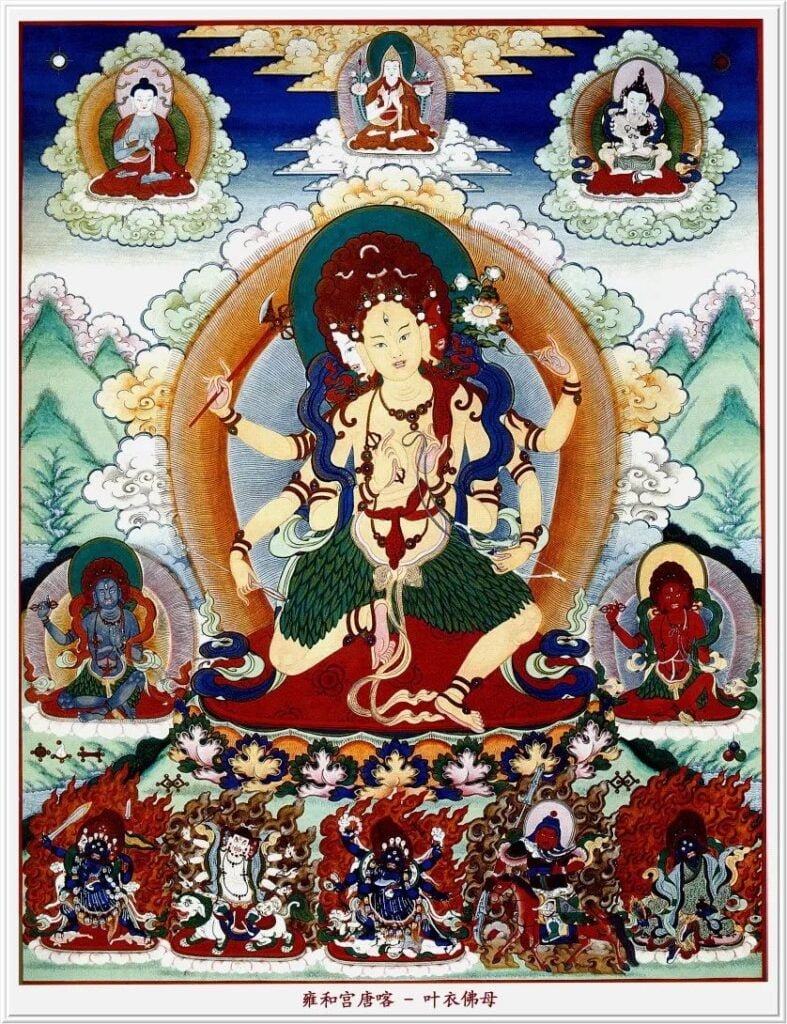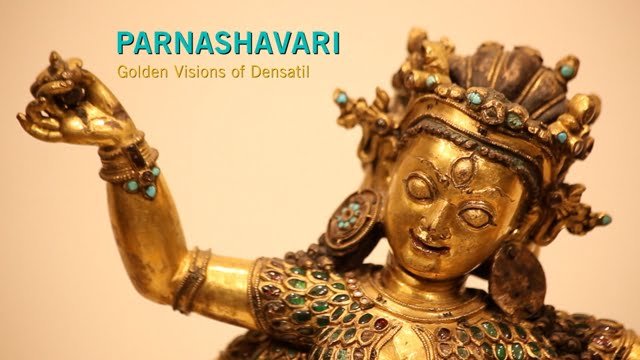Deity Parnashavari: The Leaf-Clothed Goddess of Healing in Tibetan Buddhism
Parnashavari: A Vital Messenger in Tibetan Buddhism
Goddess Parnashavari, known as the “Leaf-Clothed Goddess” (རི་ཁྲོད་ལོ་མ་གྱོན་མ།) in Tibetan Buddhism, holds a prominent position as one of the most important messenger goddesses. She is particularly revered for her role in alleviating diseases, especially infectious ones like epidemics. Practicing Parnashavari’s visualization and mantra is believed to strengthen the immune system, shielding practitioners from illnesses.
Parnashavari holds a special place in the world of spirituality. Her name, derived from Sanskrit, signifies the enchanting imagery of a deity draped in leaves and peacock feathers. This mystical goddess, sometimes referred to as “Parnashavari Bodhisattva” or “Parnashavari Guanyin,” plays a pivotal role as the chief figure in the Lotus Tantra tradition. Let’s delve into the fascinating realm of Parnashavari and discover her extraordinary abilities and significance.
Widespread Practice Across Tibetan Buddhism
All schools of Tibetan Buddhism engage in the practice of Parnashavari, with the Kagyu tradition, especially the Drikung Kagyu, being particularly devoted. Her practice is a key component of the ten-day teachings held during the Year of the Snake, traditionally organized every 12 years. During this time, followers from various Tibetan Buddhist schools gather at Drikung Thil Monastery to participate in the teachings and practice sessions led by the head lama.
Parnashavari in Thangka Art: Symbolism and Iconography
In Thangka paintings, Parnashavari is depicted with a milky-white complexion, symbolizing the dual Buddhist activities of pacifying and enriching. This indicates her role in calming negative causes and fostering positive actions for healing and protection. She has three faces, each with three eyes: the main face is half-smiling, half-wrathful in a milky-white color, signifying harmony with nature; the left face is red, representing desire, and the right face is white, symbolizing tranquility. Adorned with a crown of flowers and a topknot secured with a white snake, she wears earrings, bracelets, armlets, anklets, and a necklace of jewels, entwined with a garland of leaves, signifying her healing and regenerative powers.
The Enigmatic Appearance:
Parnashavari’s visual representation is both intriguing and symbolic. She takes the form of a celestial goddess, adorned with a crown that embodies the image of the Buddha of Infinite Life. Her body is beautifully ornamented with divine jewelry, and a radiant halo of fire envelops her form. With four arms, her right-hand gestures offer auspicious fruits, while her left-hand wields a vajra-tipped arrow. She sits gracefully upon a lotus, and her golden complexion radiates purity. Her attire is complete with the Five Dhyani Buddhas’ crown, signifying the bestowing of Amrita or divine nectar.
The Divine Protector:
Parnashavari is renowned as the “Goddess who Heals All Ailments.” She resides in remote mountain regions, often depicted adorned in a garb of leaves, safeguarding practitioners deep in the heart of dense forests. Devotees turn to her for protection against various diseases, with her practice known as the “Parnashavari Tantra.” This divine goddess is believed to hold unmatched potency in combating epidemics and contagious illnesses, making her the patron deity of spiritual masters who seek to eliminate ailments and obstacles on their path to enlightenment.

The Power of Six Arms:
Parnashavari’s six arms carry profound symbolism. Three faces, each with three eyes, express a range of emotions from serenity to wrath. Her right hands hold a vajra and an arrow, showcasing her protective and wish-granting abilities. On the left, she carries a noose, a bow, and a lotus branch, signifying her compassionate nature. Her transformative powers extend to manifesting as a wrathful deity, dispelling malevolent forces and obstacles.
Her Six Arms and Their Meanings
Parnashavari’s six arms represent various aspects of her divine attributes:
- The main arms hold a golden vajra and a noose, symbolizing indestructible wisdom and control over internal and external elements.
- The second set of arms wields a vajra axe and a blue lotus, signifying the power to eradicate disease.
- The third set holds a bow and arrow, representing the wisdom to penetrate ultimate truth and the power to aim the arrow of wisdom towards this goal.
- She dances atop a lotus pedestal, embodying the essence of purity and enlightenment.
The Thangka’s Spiritual Assembly
At the top center of the Thangka, Tsongkhapa, the founder of the Gelugpa school, is depicted, flanked by the Dragon King Buddha on his right and Vajradhara on the left. The lower part of the Thangka features the Six-Armed Protector in the center, with the Career-Protecting King and the Four-Armed Protector on the right, and Guan Yu and Shanglon Protectors on the left.
Parnashavari’s representation in Thangka art is not just an artistic depiction; it is a visual guide to her spiritual attributes and the protective and healing powers she bestows upon her followers
Parnashavari Mantra: A Powerful Elixir of Healing and Protection
The Rituals and Mantras:
Devotees of Parnashavari engage in specific rituals and mantra recitations to invoke her blessings. By meditating on her form and chanting her mantra, practitioners aim to purify karma, extend their lifespan, and attain spiritual liberation. The potency of her blessings is particularly emphasized during challenging times when healing and protection are sought.
The Parnashavari Mantra, also known as the “Heart Mantra,” is a profound incantation that holds the key to healing and safeguarding against diseases and epidemics. With its roots in Buddhist tradition, this mantra invokes the blessings of Parnashavari, the Goddess of Protection against plagues and contagious ailments. In this article, we explore the merits and significance of the Parnashavari Mantra, uncovering its immense potential for healing and well-being.
The Essence of the Mantra:
The Parnashavari Mantra, pronounced as “ཨོཾ་པི་ཤ་ཙི་པརྞ་ཤ་ཝ་རི་སརྦ་ཛྭ་ར་པྲ་ཤཱ་མ་ན་ཡེ་སྭཱ་ཧཱ།
(OM PISHATSI PARNA SHAVARI SARVA ZVARA PRASHA MANI SVAHA) encapsulates the essence of divine protection. Chanting this mantra is believed to bring forth the compassionate energy of Parnashavari and seek her intervention in times of health crises.
The Merits of Chanting:
The primary virtue of reciting the Parnashavari Mantra is its extraordinary ability to dispel various forms of illnesses. This mantra serves as a potent antidote against ailments, particularly effective in combating plagues, infectious diseases, and toxins. It is said that in the face of microscopic viruses that threaten human existence, the power of this mantra shines brightly.
Parnashavari: The Guardian Against Epidemics:
Parnashavari is revered as the guardian goddess who shields against the scourge of epidemics and viral infections. Within Buddhist scriptures, there are prophecies of future calamities caused by “airborne pests” that could lead to widespread devastation. In such fragile moments of life, where uncertainty looms, the Parnashavari Mantra offers solace and hope. Devotees believe that by invoking her divine presence through this mantra, they can dispel all epidemics and diseases.
The Ritual of Protection:
The practice of chanting the Parnashavari Mantra is not merely a recitation; it is a powerful ritual of protection. By visualizing Parnashavari with boundless compassion, devotees seek her intervention to eliminate diseases and suffering. This visualization involves imagining her radiant gaze simultaneously showering healing light upon oneself and all those affected by the epidemic. The mantra becomes a beacon of hope and a source of strength during challenging times.
The Spread of Healing:
The efficacy of the Parnashavari Mantra extends beyond personal well-being. It has the potential to eliminate epidemics, increase merit and prosperity, and ensure the welfare of communities and nations. As individuals, we must diligently practice and cultivate inner purification, dedicating the merits of our efforts to the benefit of all sentient beings. The mantra’s unique power lies in its ability to counteract diseases, even those that resist conventional treatments.


















